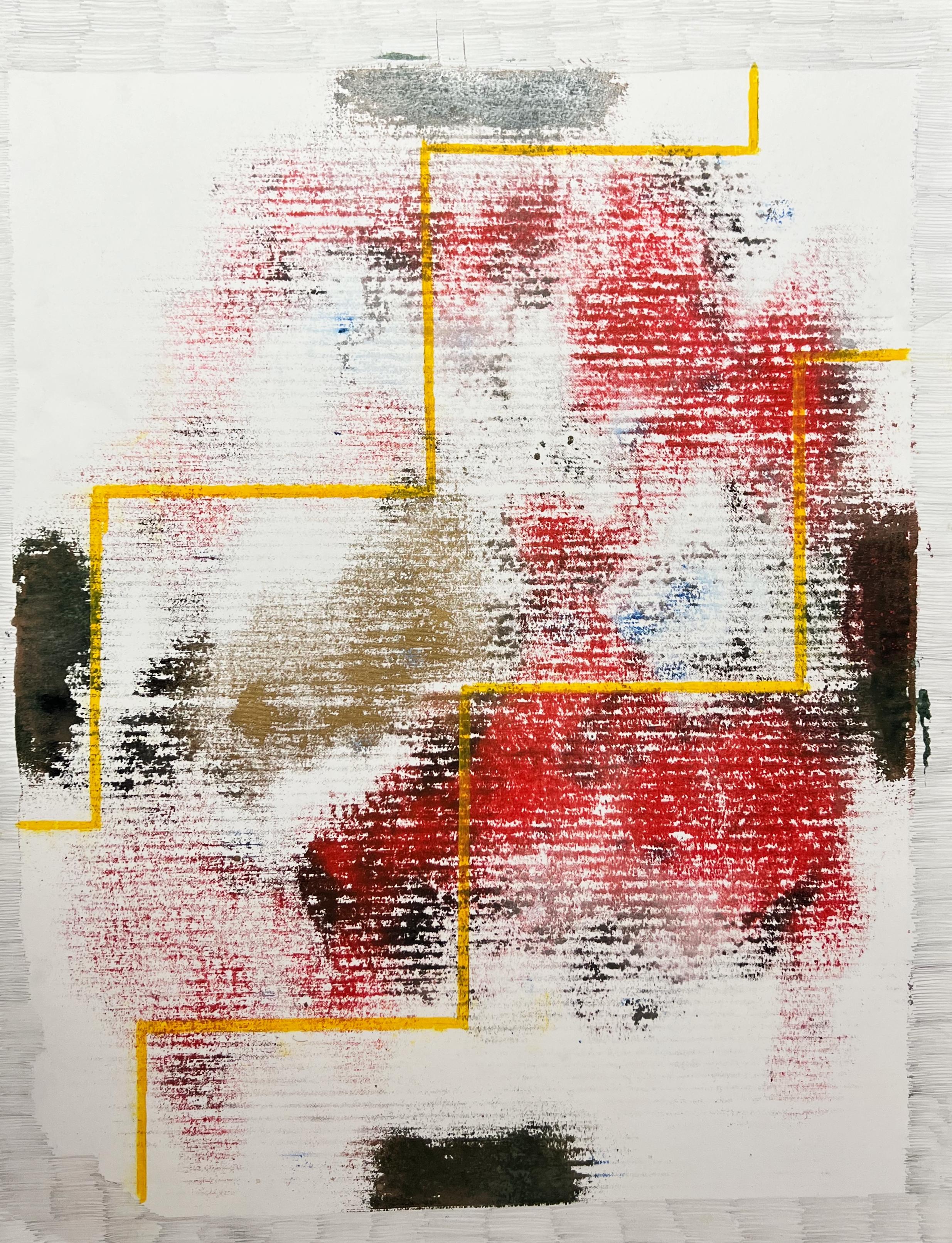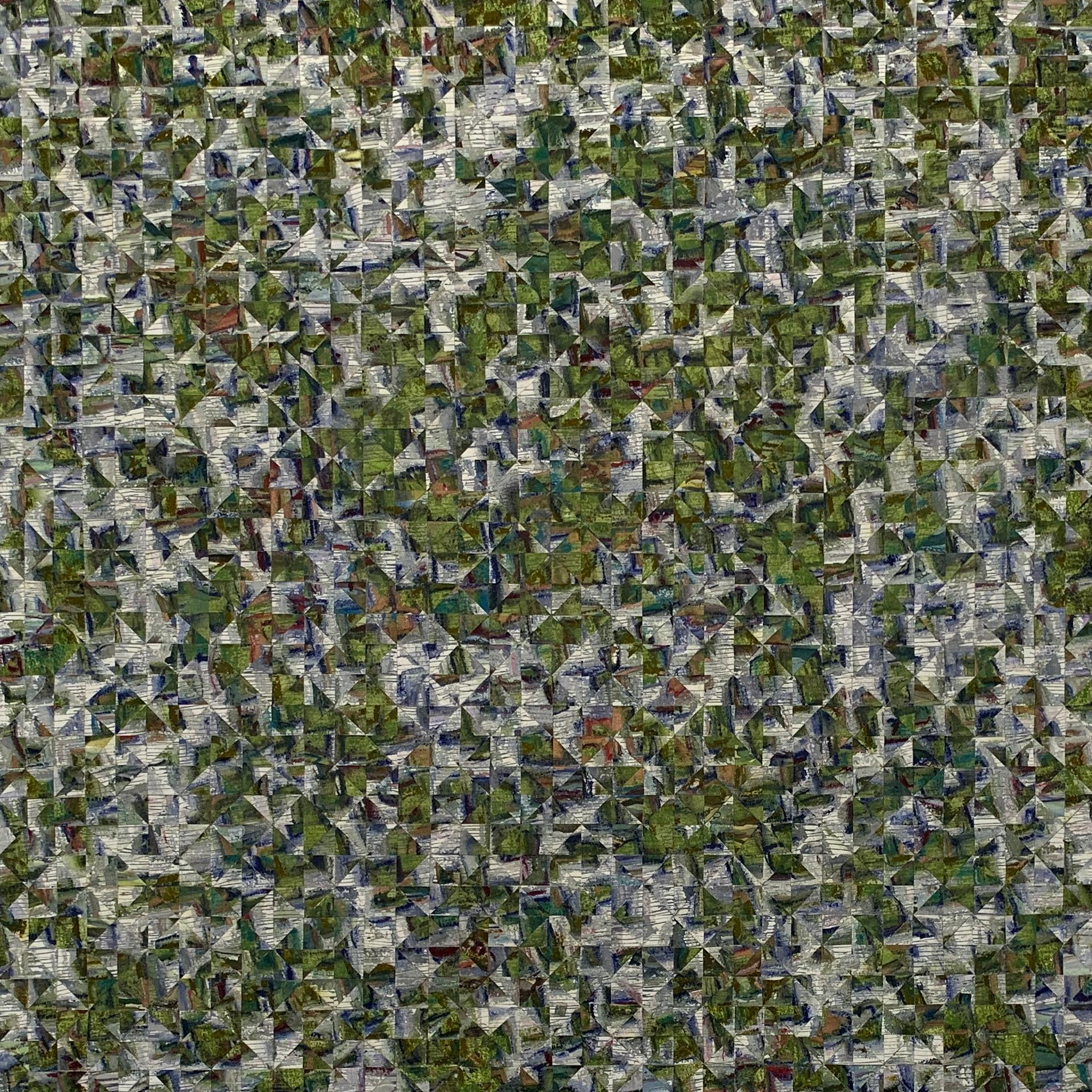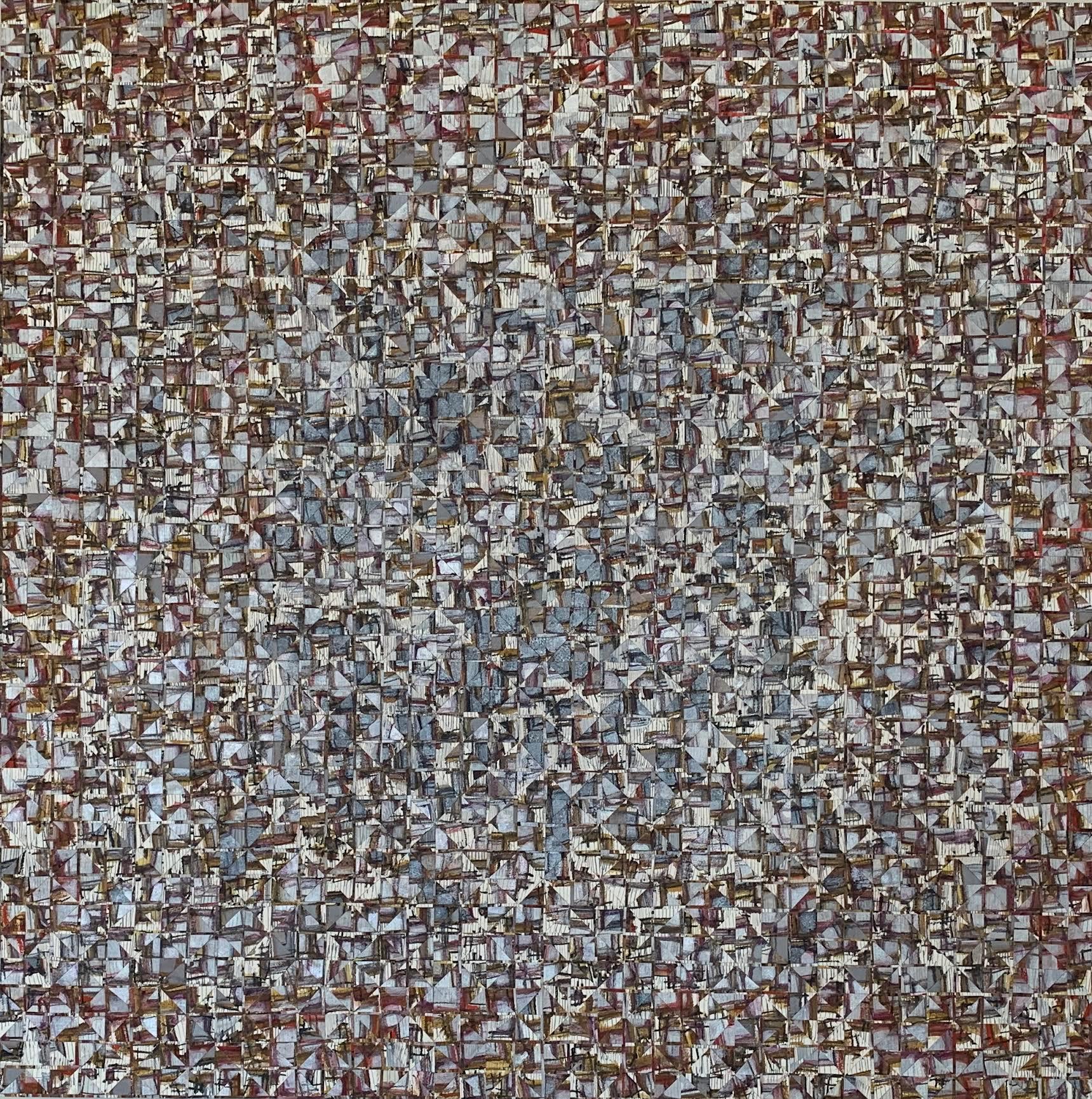Sol LeWittUnique drawing Geometric Abstraction on postcard conceptual art (hand signed)1982
1982
About the Item
- Creator:Sol LeWitt (1928 - 2007, American)
- Creation Year:1982
- Dimensions:Height: 5.8 in (14.74 cm)Width: 4.1 in (10.42 cm)
- Medium:
- Movement & Style:
- Period:
- Condition:Very good vintage condition. This card was mailed from Spoleto Italy to Waterbury Connecticut in 1982 - but excellent despite journey! This work ships framed. It has been elegantly framed with beveled edges and colored matting.
- Gallery Location:New York, NY
- Reference Number:1stDibs: LU1745212441622
Sol LeWitt
While New York City’s art scene in the 1950s and ’60s revolved around Abstract Expressionism, multidisciplinary artist Sol LeWitt paved an alternative path, creating a prolific output of work in the genres of minimalism and, later, Conceptual art.
While LeWitt is perhaps best known for his immense “wall drawings,” he created work in a wide range of media, including drawing, painting, printmaking and sculpture. (However, in a characteristic rebuttal of canonical art history, he referred to these pieces as “structures.”) He also produced several texts, including the seminal Sentences on Conceptual Art (1969).
Born in Hartford, Connecticut, in 1928, LeWitt received a BFA from Syracuse University before going to work as a graphic designer for the renowned architect I.M. Pei. He would later work at the book counter at the Museum of Modern Art, where his colleagues included fellow artists. LeWitt’s early exposure to architecture may well have had outsize influence on his subsequent career: He was known for the geometric nature of his work, specifically his fastidious, near-obsessive treatment of the cube, which he rendered repeatedly in various ways throughout his paintings, structures and wall drawings.
In the 1960s, LeWitt showed in several group exhibitions throughout New York and also began to experiment with three-dimensional structures, most modular riffs on the cube shape. His work was included in “Working Drawings and Other Visible Things on Paper Not Necessarily Meant to Be Viewed as Art,” curated by Mel Bochner, another leading exponent of Conceptualism.
Later, LeWitt debuted his now-iconic wall drawings, creating work directly on the walls of galleries and show spaces, beginning with pioneering gallerist Paula Cooper’s inaugural show in 1968. The wall drawings became a prime example of LeWitt’s philosophical approach to art, with their installation often carried out by museum staff or curators following precise instructions from the artist.
“The idea,” the artist once said, “becomes a machine that makes the art.” LeWitt continued to produce work until his death in 2007.
Find a collection of original Sol LeWitt art on 1stDibs.
- ShippingRetrieving quote...Ships From: New York, NY
- Return PolicyA return for this item may be initiated within 1 day of delivery.
- "This is for Nadine": hand signed unique marker drawing in exhibition catalogueBy James SienaLocated in New York, NYJames Siena "This is for Nadine", signed drawing, 2005 Original drawing done in black marker, bound in the title page of softcover PACE Gallery catalogue with stiff wraps hand signe...Category
Early 2000s Abstract Geometric Abstract Drawings and Watercolors
MaterialsPaper, Ink, Mixed Media, Lithograph, Offset, Felt Pen
- Color Circle and StarBy Polly ApfelbaumLocated in New York, NYPolly Apfelbaum Color Circle and Star, 2004 Fabric Marker and Fabric Dye on Velvet Cotton Signed and dated in ink by the artist on the front with artist's inkstamp. Frame Included Si...Category
Early 2000s Abstract Geometric Mixed Media
MaterialsFabric, Dye, Ink, Mixed Media, Permanent Marker
- Intersecting Magic SquareBy Charmion von WiegandLocated in New York, NYCharmion von Wiegand Intersecting Magic Square, ca. 1963 Gouache on paperboard Signed and titled on the back of the artwork. The signature shown on the frame back is a photo of the actual signature on the artwork itself. Frame Included: elegantly floated and framed in hand made white wood museum frame with UV plexiglass This work is signed and titled on the back of the artwork itself. The signature shown on the back of the frame is a photo of the actual signature, since the actual pencil signature and title is on the artwork itself, which can't be seen within the frame Measurements: Frame: 21 x 17 x 1.5 inches Artwork: 18 x 14.25 inches The Estate of the celebrated artist Charmion Von Wiegand has been represented exclusively by Michael Rosenfeld...Category
1960s Abstract Geometric Abstract Paintings
MaterialsGouache, Handmade Paper, Mixed Media, Pencil
- Lyrical Abstraction Abstract Expressionist painting for Sonoma CA (signed heart)By Robert NatkinLocated in New York, NYRobert Natkin Lyrical Abstraction for the Sonoma Mission Inn, Sonoma, California, 1990 Acrylic on paper painting with collaged element Signed twice by the ...Category
1990s Abstract Geometric Abstract Paintings
MaterialsPaper, Mixed Media, Acrylic, Pencil
- Untitled Chevron Collage, de-accessioned from the Honolulu Museum of ArtBy Kenneth NolandLocated in New York, NYKENNETH NOLAND Untitled, for Trustees of the Honolulu Museum of Art, 1984 Mixed Media collage with silver and colored foil on board. Signed on verso (back) with personal inscription. "for Twig and Laila" (Trustees of the Honolulu Museum of Art), Deaccessioned from the Honolulu Museum of Art Collection Inscription done in black marker and reads: "A Little Exercise For Twig and Laila With Thanks For A Wonderful 3 Days At ' Cedar House' On The 'Big Island'... 1 Sept 1984 Honolulu Hawaii." Frame included Measurements Framed: 12.5" x 12.5" x .3" Artwork: 8.75" x 8.75" This reflective Chevron collage was de-accessioned by the Honolulu Museum of Art. In 2018, it was exhibited in the show "On Black Mountain: The Bauhaus Legacy in America", April 5, 2019-April 27, 2019 at the Sager Braudis Gallery in Columbia, Missouri, and is reproduced in the exhibition catalogue. Unique signed and dedicated mixed media collage with silver and colored foil on board by the important Color Field painter Kenneth Noland. It's quite a dazzling work, combining color field, geometric abstraction with Op Art, as the work changes appearance and color with the reflected and refracted light. - sometimes appearing light; sometimes darker. See the photos -- there's a light one and a darker one - and they both depict the same work. What's so impressive is that this work literally changes color depending on how the light reflects against it. The artist wrote a personal and heartfelt inscription on the verso to "Twig and Laila". (Twig (sic), which the artist deliberately misspells, is Thurston Twigg Smith, former publisher of The Honolulu Advertiser, who was married to New York philanthropist Laila Twigg Smith. Laila had lived in Hawaii since 1970, where she and her husband had put together a substantial collection of contemporary art. Unfortunately, the two divorced in 1996 and soon after she returned to New York. Two years later, in 1998, Laila died of liver failure at the young age of only 53. Laila was a major philanthropist and art collector who moved from Manhattan to Hawaii. She was a board member of the New Museum of Contemporary Art in New York and a major donor the Honolulu Museum in Hawaii. Laila donated the present Ken Noland...Category
1980s Abstract Geometric Mixed Media
MaterialsFoil
- 6/21/96.9 (hand signed and dated original graphite drawing; unique)By Peter HalleyLocated in New York, NYPETER HALLEY 6/21/96.9, 1998 Graphite and ink drawing Hand-signed by artist, signed and dated in graphite lower right front; lower left front bears title: 6/21/96.9 Frame included: e...Category
1990s Abstract Geometric Abstract Drawings and Watercolors
MaterialsInk, Graphite
- 'Roofs of Ravello', Mid-Century Abstract, Harvard Fogg Museum, SFAA, Carmel, AICLocated in Santa Cruz, CAInitialed lower right, 'M. W.' for Margaret Wentworth (American, 1914-1999) and dated 1959. Exhibited: Feingarten Galleries, Carmel, California, 1960, and titled on label, verso, 'Ro...Category
1950s Abstract Geometric Abstract Paintings
MaterialsEgg Tempera, Postcard, Pen
- 1950s Abstract Composition in Brown, Orange and Blue with Black Parallel LinesBy Herbert BayerLocated in Denver, COWatercolor and ink on paper of an abstract composition of brown, orange and blue shapes between black parallel lines throughout the the piece by Herbert Bayer (1900-1985). Presented in a custom black frame with all archival materials. Framed dimensions measure 17 ⅞ x 22 ⅝ x 1 inches. Image size is 10 ¼ x 15 ½ inches. Painting is clean and in very good condition - please contact us for a detailed condition report. Expedited and international shipping is available - please contact us for a quote. About the Artist: Herbert Bayer enjoyed a versatile sixty-year career spanning Europe and America that included abstract and surrealist painting, sculpture, environmental art, industrial design, architecture, murals, graphic design, lithography, photography and tapestry. He was one of the few “total artists” of the twentieth century, producing works that “expressed the needs of an industrial age as well as mirroring the advanced tendencies of the avant-garde.” One of four children of a tax revenue officer growing up in a village in the Austrian Salzkammergut Lake region, Bayer developed a love of nature and a life-long attachment to the mountains. A devotee of the Vienna Secession and the Vienna Workshops (Wiener Werkstätte) whose style influenced Bauhaus craftsmen in the 1920s, his dream of studying at the Academy of Art in Vienna was dashed at age seventeen by his father’s premature death. In 1919 Bayer began an apprenticeship with architect and designer, Georg Schmidthamer, where he produced his first typographic works. Later that same year he moved to Darmstadt, Germany, to work at the Mathildenhöhe Artists’ Colony with architect Emanuel Josef Margold of the Viennese School. As his working apprentice, Bayer first learned about the design of packages – something entirely new at the time – as well as the design of interiors and graphics of a decorative expressionist style, all of which later figured in his professional career. While at Darmstadt, he came across Wassily Kandinsky’s book, Concerning the Spiritual in Art, and learned of the new art school, the Weimar Bauhaus, in which he enrolled in 1921. He initially attended Johannes Itten’s preliminary course, followed by Wassily Kandinsky’s workshop on mural painting. Bayer later recalled, “The early years at the Bauhaus in Weimar became the formative experience of my subsequent work.” Following graduation in 1925, he was appointed head of the newly-created workshop for print and advertising at the Dessau Bauhaus that also produced the school’s own print works. During this time he designed the “Universal” typeface emphasizing legibility by removing the ornaments from letterforms (serifs). Three years later he left the Bauhaus to focus more on his own artwork, moving to Berlin where he worked as a graphic designer in advertising and as an artistic director of the Dorland Studio advertising agency. (Forty years later he designed a vast traveling exhibition, catalog and poster -- 50 Jahre Bauhaus -- shown in Germany, South America, Japan, Canada and the United States.) In pre-World War II Berlin he also pursued the design of exhibitions, painting, photography and photomontage, and was art director of Vogue magazine in Paris. On account of his previous association with the Bauhaus, the German Nazis removed his paintings from German museums and included him among the artists in a large exhibition entitled Degenerate Art (Entartete Kunst) that toured German and Austrian museums in 1937. His inclusion in that exhibition and the worsening political conditions in Nazi Germany prompted him to travel to New York that year with Marcel Breuer, meeting with former Bauhaus colleagues, Walter Gropius and László Moholy-Nagy to explore the possibilities of employment after immigration to the United States. In 1938 Bayer permanently relocated to the United States, settling in New York where he had a long and distinguished career in practically every aspect of the graphic arts, working for drug companies, magazines, department stores, and industrial corporations. In 1938 he arranged the exhibition, “Bauhaus 1919-1928” at the Museum of Modern Art, followed later by “Road to Victory” (1942, directed by Edward Steichen), “Airways to Peace” (1943) and “Art in Progress” (1944). Bayer’s designs for “Modern Art in Advertising” (1945), an exhibition of the Container Corporation of America (CAA) at the Art Institute of Chicago, earned him the support and friendship of Walter Paepcke, the corporation’s president and chairman of the board. Paepcke, whose embrace of modern currents and design changed the look of American advertising and industry, hired him to move to Aspen, Colorado, in 1946 as a design consultant transforming the moribund mountain town into a ski resort and a cultural center. Over the next twenty-eight years he became an influential catalyst in the community as a painter, graphic designer, architect and landscape designer, also serving as a design consultant for the Aspen Cultural Center. In the summer of 1949 Bayer promoted through poster design and other design work Paepcke’s Goethe Bicentennial Convocation attended by 2,000 visitors to Aspen and highlighted by the participation of Albert Schweitzer, Arthur Rubenstein, Jose Ortega y Gasset and Thornton Wilder. The celebration, held in a tent designed by Finnish architect Eero Saarinen, led to the establishment that same year of the world-famous Aspen Music Festival and School regarded as one of the top classical music venues in the United States, and the Aspen Institute for Humanistic Studies in (now the Aspen Institute), promoting in Paepcke’s words “the cross fertilization of men’s minds.” In 1946 Bayer completed his first architecture design project in Aspen, the Sundeck Ski Restaurant, at an elevation of 11,300 feet on Ajax Mountain. Three years later he built his first studio on Red Mountain, followed by a home which he sold in 1953 to Robert O. Anderson, founder of the Atlantic Richfield Company who became very active in the Aspen Institute. Bayer later designed Anderson’s terrace home in Aspen (1962) and a private chapel for the Anderson family in Valley Hondo, New Mexico (1963). Transplanting German Bauhaus design to the Colorado Rockies, Bayer created along with associate architect, Fredric Benedict, a series of buildings for the modern Aspen Institute complex: Koch Seminar Building (1952), Aspen Meadows guest chalets and Center Building (both 1954), Health Center and Aspen Meadows Restaurant (Copper Kettle, both 1955). For the grounds of the Aspen Institute in 1955 Bayer executed the Marble Garden and conceived the Grass Mound, the first recorded “earthwork” environment In 1973-74 he completed Anderson Park for the Institute, a continuation of his fascination with environmental earth art. In 1961 he designed the Walter Paepcke Auditorium and Memorial Building, completing three years later his most ambitious and original design project – the Musical Festival Tent for the Music Associates of Aspen. (In 2000 the tent was replaced with a design by Harry Teague.) One of Bayer’s ambitious plans from the 1950s, unrealized due to Paepcke’s death in 1960, was an architectural village on the outskirts of the Aspen Institute, featuring seventeen of the world’s most notable architects – Walter Gropius, Marcel Breuer, I.M. Pei, Minoru Yamasaki, Edward Durrell Stone and Phillip Johnson – who accepted his offer to design and build houses. Concurrent with Bayer’s design and consultant work while based in Aspen for almost thirty years, he continued painting, printmaking, and mural work. Shortly after relocating to Colorado, he further developed his “Mountains and Convolutions” series begun in Vermont in 1944, exploring nature’s fury and repose. Seeing mountains as “simplified forms reduced to sculptural surface in motion,” he executed in 1948 a series of seven two-color lithographs (edition of 90) for the Colorado Springs Fine Arts Center. Colorado’s multi-planal typography similarly inspired Verdure, a large mural commissioned by Walter Gropius for the Harkness Commons Building at Harvard University (1950), and a large exterior sgraffito mural for the Koch Seminar Building at the Aspen Institute (1953). Having exhausted by that time the subject matter of “Mountains and Convulsions,” Bayer returned to geometric abstractions which he pursued over the next three decades. In 1954 he started the “Linear Structure” series containing a richly-colored balance format with bands of sticks of continuously modulated colors. That same year he did a small group of paintings, “Forces of Time,” expressionist abstractions exploring the temporal dimension of nature’s seasonal molting. He also debuted a “Moon and Structure” series in which constructed, architectural form served as the underpinning for the elaboration of color variations and transformations. Geometric abstraction likewise appeared his free-standing metal sculpture, Kaleidoscreen (1957), a large experimental project for ALCOA (Aluminum Corporation of America) installed as an outdoor space divider on the Aspen Meadows in the Aspen Institute complex. Composed of seven prefabricated, multi-colored and textured panels, they could be turned ninety degrees to intersect and form a continuous plane in which the panels recomposed like pieces of a jigsaw puzzle. He similarly used prefabricated elements for Articulated Wall, a very tall free-standing sculpture commissioned for the Olympic Games in Mexico...Category
1950s Abstract Geometric Abstract Drawings and Watercolors
MaterialsPaper, Ink, Mixed Media, Watercolor
- Colorful painting on paper, Unique piece, Abstract ExpressionistLocated in Carballo, ESTUSET (1997, A Coruña, España) Mixed media painting on paper Ready to frame One-of-a-kind Signed on back Includes certificate of authenticity 2021 65 x 50 cm. It belongs to the ser...Category
21st Century and Contemporary Abstract Geometric Abstract Paintings
MaterialsPaper, Oil Crayon, Ink, Mixed Media, Acrylic, Pencil
- Quadrants EphemeralBy Irene ZweigLocated in Burlingame, CA'Quadrants Ephemeral' from Irene Zweig, where intellect, science, mathematics and order are at play in shades of green, blue, grey and white, in the abstract mixed media painting tha...Category
21st Century and Contemporary Abstract Geometric Abstract Paintings
MaterialsWood, Ink, Mixed Media, Watercolor
- Quadrants QuadrilleBy Irene ZweigLocated in Burlingame, CA'Quadrants Quadrille' from Irene Zweig, where intellect, science, mathematics and order are at play in shades of calm blue, silver, grey and white, in the abstract mixed media painti...Category
21st Century and Contemporary Abstract Geometric Abstract Paintings
MaterialsWood, Ink, Mixed Media, Watercolor
- Square of Sublimity IVBy Irene ZweigLocated in Burlingame, CA'Square of Sublimity IV' from Irene Zweig, where intellect, science, mathematics and order are at play in shades of yellow, green, and rust in the abstract mixed media painting that ...Category
21st Century and Contemporary Abstract Geometric Abstract Paintings
MaterialsMixed Media, Watercolor, Wood, Ink






